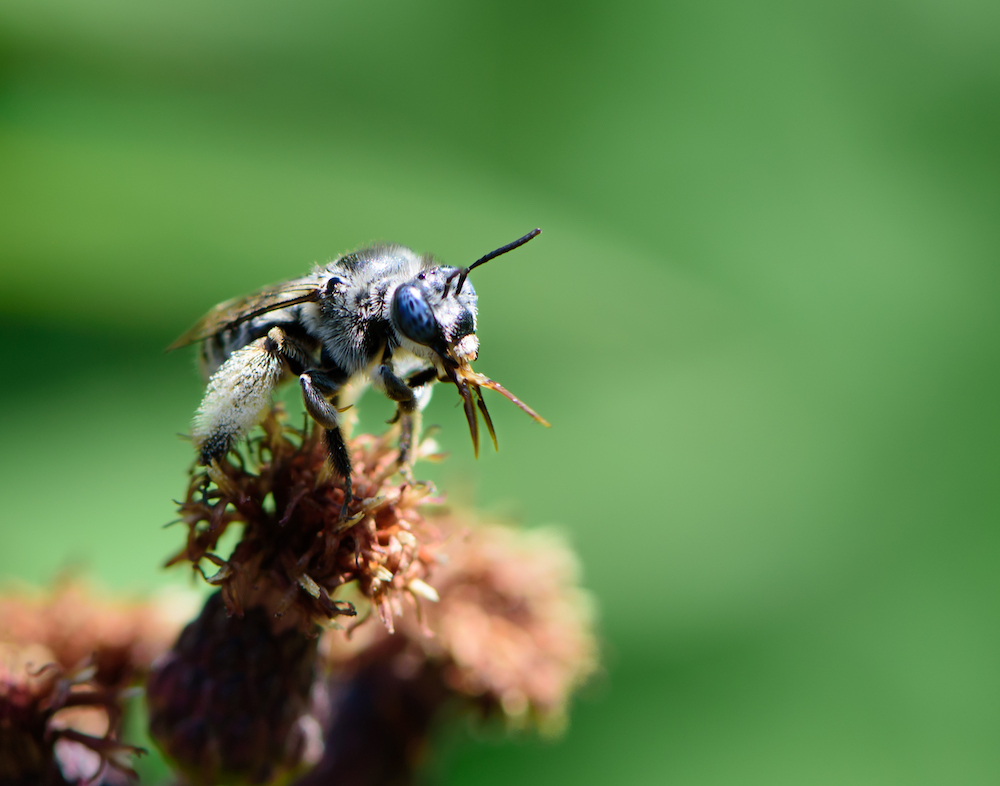There’s more to bees than honey
Discover the hidden world of our native bees and their vital role in local ecosystems as we highlight their unique appearances, behaviors, and interactions with plants.

Common eastern bumble bee (Bombus impatiens) on goldenrod
These bumble bees are a more familiar native bee species. Bumble bees don’t make honey, and are wider than honey bees, but they do nest in social hives with workers and queens. Queens are larger than workers and are the only bees in the hive that reproduce.
Confusing furrow bee (Halictus confusus)
An average specimen of these small bees will be only around 1/4 inches long. They nest in underground, social hives, but the queens don’t look much different from the workers, and the female workers can sometimes reproduce.
This individual is concentrating nectar in their mouthparts (look for the bead of nectar under the head). By gathering nectar on their mouth and letting the water evaporate, bees increase the sugar content of the nectar, making it more nutritious. The evaporation also keeps bees cool on hot days.


Small carpenter bee (Ceratina sp.) on chicory
There are 25 species of small carpenter bees native to North America. In Michigan, the largest of these Ceratina only grow to be 1/3 inch long (8 millimeters).
They are called carpenter bees because they build their nests inside wood, specifically the pithy stems of dead shrubs and flowers. These bees live and hibernate in their nests alone.
Green sweat bee (Tribe Augochlorini)
There are four species of metallic, copper-green bees in Michigan that are distributed among two genera, Augochlorella and Augochlora.
These bees look very similar and can only be confidently differentiated by closely examining their wing veins and facial features. They can nest alone or in semi-social groups and in dead wood or underground.


Metallic sweat bee (Genus Lasioglossum Subgenus Dialictus) on yellow rocketcress
Another petite bee, the largest individuals are less than half an inch long (12 millimeters). Their reflective skin can have a variety of colors, including light aquamarine, olive green, red, and gunmetal blue. They are solitary and nest underground.
Familiar masked bee (Hylaeus affinis)
The ivory markings on the faces of bees from the Genus Hylaeus earned the group its common name, masked bees. Unlike other bees, which collect pollen on their leg hairs, masked bees collect pollen inside a special compartment in their stomachs.
When they return to their nests, they regurgitate the pollen as a soupy mixture for their larvae to eat. They make their nests inside dead twigs and line them with a clear, waterproof, cellophane-like material.


Metallic sweat bee (Genus Lasioglossum Subgenus Dialictus) on yellow rocketcress
Another petite bee, the largest individuals are less than half an inch long (12 millimeters). Their reflective skin can have a variety of colors, including light aquamarine, olive green, red, and gunmetal blue. They are solitary and nest underground.
Denticulate longhorn bee (Melissodes denticulatus) on ironweed
Many bees are generalists that eat pollen from many kinds of plants, but around a quarter of the United States’ native bees are considered specialists because they strongly prefer pollen from a very specific group of plants.
Their preference for specific plants makes specialist bees more vulnerable to losses in habitat and plant biodiversity than generalist bees. Denticulate longhorn bees almost exclusively collect pollen from ironweeds, for instance, so if ironweeds disappear from a landscape, longhorn bee numbers are sure to decline.

The bee in this photo is showing off her proboscis, the straw-like tongue that bees use to eat nectar.

The bee in this photo is showing off her proboscis, the straw-like tongue that bees use to eat nectar.
Eastern cucurbit bee (Peponapis pruinosa) on summer squash
Specialist bees can also be important crop pollinators. The eastern cucurbit bee (aka Pruinose squash bee) almost exclusively collects the pollen of squash and pumpkins.
In areas where there are enough squash bees, adding domestic honey bee hives doesn’t impact how much fruit squash plants produce, according to multiple studies.
Mining bee (Genus Andrena) on black cherry
Mining bees, which are named for the underground tunnels that they build their nests in, are one of the most important pollinators for fruit trees that bloom in the early spring. One such tree is the Michigan-native black cherry. Mining bees carry 18 times more black cherry pollen than other bees that commonly visit black cherry flowers, according to a 2022 study.
Mining bees are also very important pollinators of apple trees. They can be some of the most abundant native bees on apple orchards and deposit around 2.5 times more apple pollen per flower visit than honey bees, according to a 2016 study.

About the photographers and writer
Annie Barget is a hobby photographer with a preference for nature photography. She took several photography classes in high school and a study abroad program. She also worked as a photographer for the University of Michigan, where she photographed fish specimens for an online database.
Derek Smith is a science writer and hobby photographer who started his journey into the world of insect macrophotography this year. He loves how photography allows him to appreciate the small and otherwise unnoticed things in nature. Outside this exhibit, his writing was featured in Eos, Hakai Magazine, Scientific American, and the University of Michigan News.
Annie and Derek thank the Plymouth Apple Orchards & Cider Mill for allowing them to photograph bees on their crops; Drs. Joseph Wilson, Jason Gibbs, and John Ascher for assisting with bee identification; Matthaei Botanical Gardens for providing frames and placards; Alexis Ford for assisting with installation; and their friends and family for their excitement and support.